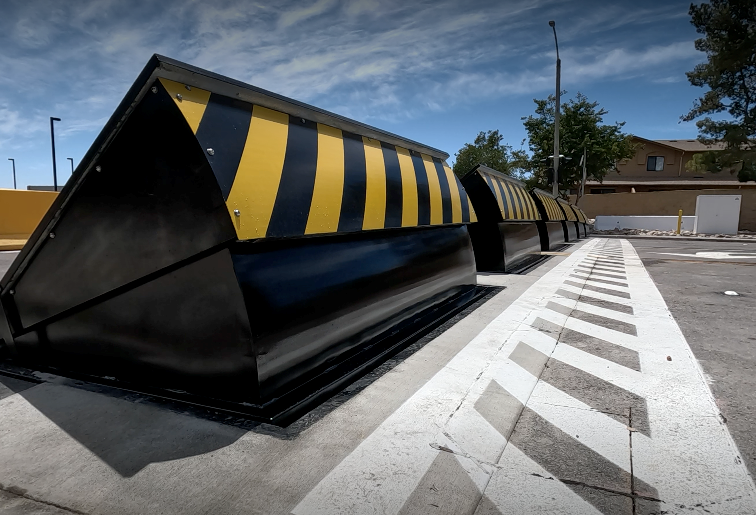Get This Report about Wedge Barriers
Table of ContentsWedge Barriers Can Be Fun For EveryoneHow Wedge Barriers can Save You Time, Stress, and Money.

The Only Guide for Wedge Barriers
g., springtime support 65 )might be taken care of to completion of the spring rod 58 to enable compression of the springtimes 60. As the springs 60 are pressed between the spring supports 62, the springtime setting up 54 creates a force acting upon the cam paired to the spring rod 58 in an instructions 66. The staying force used to
the cam web cam deploy the wedge plate 16 may might provided offered an electromechanical actuator 84 or other various other. Thus, the spring assembly 54 and the actuator 84(e. g., electromechanical actuator)might operate with each other to convert the cam and lift the wedge plate 16.
As stated above, the springtime assembly 54 applies a continuous pressure on the web cam, while the electromechanical actuator may be controlled to put in a variable pressure on the cam, therefore enabling the training and reducing( i. e., deploying and withdrawing )of the wedge plate 16. In particular embodiments, the continuous pressure used by the springtime setting up 54 may be flexible. g., electromechanical actuator) is handicapped. As will be valued, the spring assembly 54 may be covered and safeguarded from particles or various other elements by a cover plate(e. g., cover plate 68 shown in FIG. 4) that may be considerably flush with the elevated surface area 38 of the structure 14. As stated above, in the deployed placement, the wedge plate 16 offers to block gain access to or travel past the obstacle 10. As an more example, the obstacle 10(e. g., the wedge plate 16 )may block pedestrians or vehicles from accessing a residential property or path. As discussed over, the barrier 10 is affixed to the support 30 secured within the foundation 14,

front braces 71. Because of this, the affiliation settings up 72 may pivot and revolve to allow the collapse and expansion of the linkage settings up 72 throughout retraction and release of the bather 10. The link settings up 72 reason activity of the wedge plate 16 to be restricted. For instance, if a vehicle is taking a trip towards the released wedge plate 16(e. For instance, in one situation, the safety legs 86 may be expanded duringupkeep of the barrier 10. When the safety and security legs 86 are deployed, the safety and security legs 86 support the weight of the wedge plate 16 versus the surface area 12. Therefore, the training system 50 might be deactivated, serviced, eliminated, changed, and so forth. FIG. 5 is partial perspective sight of a personification of the surface-mounted wedge-style obstacle 10, highlighting the cam 80 and the camera surfaces 82 of the lifting mechanism 50. Particularly, 2 web cam surface areas 82, which are referred to as lower camera surface areas 83, are positioned below the camera 80. The reduced camera surfaces 83 my latest blog post may be taken care of to the surface 12 (e. For example, the reduced camera surfaces 83 and the placing plate 85 might form a solitary item that is safeguarded to the support 30 by screws or various other mechanical fasteners. In addition, two webcam surface areas 82, which are referred to as upper camera surfaces 87, are positioned above the web cam 80 and coupled to (e. In other embodiments, intervening layers or plates might be positioned in between the surface 12 and the lower camera surface areas 83 and/or the wedge plate 16 and the upper cam surface areas 87 As stated over, the camera
80 equates along the cam surface areas 82 when the wedge plate 16 is lifted from the retracted position to the deployed position. Additionally, as stated over, the springtime assembly 54 (see FIG. 3 )might provide look these up a force acting on the cam 80 in the instructions 102 via spring rod 58, which may decrease the force the electromechanical actuator 84 is called for to apply to the web cam 80 in order to actuate and raise the wedge plate 16. 1 )to the deployed position(see FIG. 4). As revealed, the webcam 80 includes track wheels 104(e. g., rollers), which contact and translate along the cam surfaces 82 during procedure.